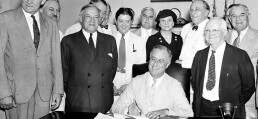The fatal flaw was FDR’s decision to make it a pay-as-you-go benefit. We should have fixed it by now.
Dec. 19, 2023 6:29 pm ET
Americans imagine that the Social Security benefits they are promised belong to them. That’s by design. In 1935, President Franklin D. Roosevelt promised to use “compulsory contributory annuities†to set up a “self-supporting system for those now young and for future generations.†Senate Finance Committee Chairman Pat Harrison (D., Miss.) repeated that claim during debate over the Social Security Act: “The annuity system will give to the worker the satisfaction of knowing that he himself is providing for his old age.â€
Yet two years later, FDR’s Justice Department successfully argued before the Supreme Court that Social Security payroll taxes weren’t reserved for future retirees. “These are true taxes, the purpose being simply to raise revenues,†assistant attorney general Robert Jackson asserted in his brief to the justices. “The proceeds are paid unrestricted into the Treasury as internal revenue collections, available for general support of the Government.â€
By 1939, Social Security taxes were collecting about 8% of federal revenue and funding part of the explosion of New Deal social spending. None of this revenue was used to purchase marketable equities or private bonds to fund future benefits. Only a notional accounting of the Social Security surpluses was recorded by the issue of nonnegotiable government bonds—which provided nothing to fund future benefits, since it was debt the federal government owed itself.
With Social Security running large cash “surpluses,†Congress started adding new benefits. These included payments for dependents and survivors, cost-of-living adjustments, disability benefits, Supplemental Security Income, a minimum benefit, a death benefit and a student benefit. When the War on Poverty and the Vietnam War triggered—and social spending and monetary expansion sustained—9.2% average annual inflation from 1973-81, the Social Security surplus quickly evaporated. By 1980, the Social Security trustees projected the fund would be depleted in 1981.
But inflation and profligacy alone didn’t bankrupt Social Security. One retiree in 1940 could be supported by a 2% payroll tax paid by 159 workers. By 1981, with growing life expectancy and an aging population, that same retiree needed a 10.7% payroll tax paid by 3.2 workers.
Hammered by demographic changes and inflation, Social Security required immediate action when President Reagan took office. His 1981 budget reconciliation bill, Gramm-Latta, ended Social Security’s adult student benefit and the minimum benefit. It also limited the death benefit. Reagan and Speaker Tip O’Neill quickly agreed to the recommendations of the Greenspan Commission’s 1983 report on Social Security’s rescue. The agreement required most federal employees to pay Social Security taxes, accelerated the implementation of the payroll tax hikes enacted in 1977, gradually raised the retirement age to 67, and delayed for six months the annual cost-of-living adjustment.
The Greenspan Commission also urged, and Congress adopted, a new supplemental federal retirement program for future federal employees that would make real investments and pay benefits based on returns. In retrospect, the biggest failure of the Reagan-O’Neill reform was that it didn’t use the 25 years during which Social Security taxes would subsequently exceed outlays to make real investments to help pay future benefits. As always seems to be the case in dealing with imminent crises, the Social Security reformers of 1983—including the Greenspan Commission, the White House, Congress and the authors of this article—focused all their attention on paying near-term benefits. We never considered investing the cash surpluses created by the reforms. We simply spent them on general government.
The actual annual Social Security cash surpluses grew from $2.7 billion in 1984 to a peak of $90 billion in 2001 and then fell to $3 billion in 2009 before turning negative. Had each annual cash surplus been invested—70% in the S&P 500 and 30% in investment-grade corporate bonds—the invested trust fund would have held $3.9 trillion of marketable assets by 2010.
Warren Buffett and Charlie Munger weren’t surprised that Albert Einstein called compound interest the most powerful force in the universe, but most of us have trouble grasping its extraordinary power. In the past 39 years, the S&P 500, cornerstone of the Federal Employee Thrift Savings Plan, has yielded on average 11% in nominal terms (including dividends). Investment-grade corporate bonds have yielded 8.4%. A 70/30 investment portfolio doubled in value every seven years.
The return on the trust fund would have far outstripped the annual cash deficits after 2010, leaving a 2023 surplus of $13.3 trillion. How long the investment of cash surpluses generated by the 1983 reform would have extended the solvency of the Social Security trust fund would have depended on many factors. How much would the continued buildup of Social Security investments have caused rates of returns to fall? How much would the increase in savings by lowering interest rates have spurred economic growth and federal revenues, including Social Security taxes? But if rates of return equaled those of the previous 39 years since the 1983 reforms, the investment of the subsequent surpluses would have guaranteed the solvency of Social Security’s long-term projections for 75 years.
Whoever becomes president on Jan. 20, 2025, will be forced to address the funding crisis of Social Security’s trust fund, which will be depleted in the last year of the mandatory 10-year budget the president must submit in the spring of 2025. No matter how the government handles the mandatory benefit cuts the depletion of the trust fund will trigger, any cash surpluses generated in the process should be invested in real assets, which must be the private property of those who have paid into the system. Pay-as-you-go systems always go but never pay. Only with private investments and the power of compound interest is a sustainable Social Security program possible.
Mr. Gramm, a former chairman of the Senate Banking Committee, is a visiting scholar at the American Enterprise Institute. Mr. Solon is an adviser to US Policy Metrics.



